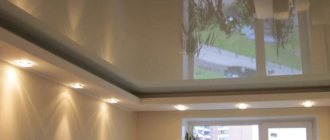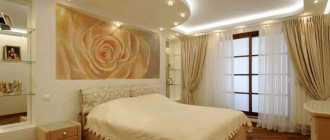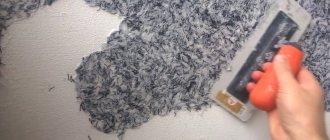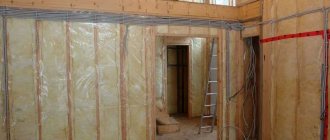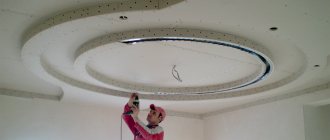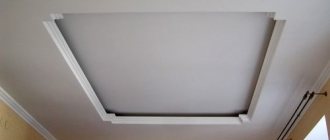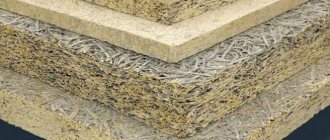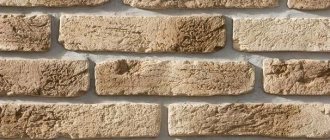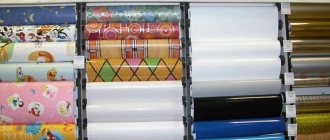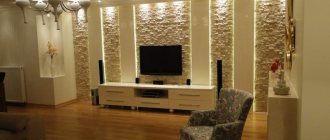Types of ceilings
Master finishers offer various methods for finishing the ceiling space. The most popular types of ceilings are:
Tension is the most common technology for decorating the ceiling space. Its essence is to attach synthetic fabric (polyester) or polyvinyl chloride (PVC) film to plastic or aluminum profiles. In this case, it is desirable to have the tension material without seams. It is made to order after measuring the ceiling. Therefore, independent work using this method of decorating the upper part of the room is difficult;
Suspension. The technological process is somewhat similar to the previous method of decorating the ceiling. The difference is in the rigidity of the frame (metal profiles are used if the ceiling is concrete, wooden beams for wooden floors or, as in attics, rafter systems) and the type of material for covering the ceiling - plasterboard, wood, metal, plastic, fiberglass or mineral fiber boards are attached. Despite the complexity of the technology, such work can be done independently;
Rack and pinion. The ceiling surface is mounted from aluminum or steel plates treated with several layers of varnish. Installed, as a rule, in unheated rooms (frost-resistant) or in rooms with high humidity (kitchen, bathroom);
Mirrored. This type of ceiling decoration is similar in design to a suspended ceiling. The only difference is that instead of gypsum boards, mirror plates are used. They visually change the volume of the room, doubling the ceiling height. This design of the upper part of the rooms was in fashion 30-40 years ago. Nowadays it is very difficult to find a mirror ceiling;
Hemmed. This is a simplified version of a suspended ceiling. The ceiling surface of this structure is also formed from rigid sheets. However, they are mounted not on a suspended structure, but on a wooden or metal frame fixed directly to the floor slabs. Such ceilings do not have the opportunity to make hidden wiring of various communications and use built-in LED lamps;
Glue is the simplest and most cost-effective option for finishing the ceiling space. There is nothing complicated here - the technological process is even more understandable for a novice finisher than whitewashing or painting.
The essence of the method is gluing square panels of polystyrene (another name is styrofoam) measuring 50x50 cm to the surface of the ceiling. The tiles can be smooth or textured, painted in one color or with an imitation of wood, granite or plaster, simply painted or with a laminated protective film and etc.;
Plastered. Using this technology, the ceiling is primed, puttied, and then covered with decorative plaster. Among the advantages of such a ceiling, one should note its durability and low cost, there are two disadvantages: high labor intensity and the standard appearance of a painted ceiling with simple painting;
Raster or cassette. It is assembled from small rectangles measuring 60x10, 120x60 cm, which professional builders call cassettes (slabs). Made from glass or pressed mineral wool. Attached to the ceiling using special frames. The cassettes have a variety of designs, which allows you to bring to life the most unusual ideas for arranging the interior in any room of the apartment (house).
Plasterboard suspended ceiling
In the decoration of ceilings, the tendency to reduce the cost of repairs and labor intensity while obtaining the maximum possible aesthetic effect is increasingly evident. The most beautiful design of the ceiling space is obtained by using suspended structures with sewn plasterboard. This technological solution for finishing the ceiling allows:
- hide ceiling problems (misalignment, cracks, chips, visible joints, etc.);
- hide various types of wiring and cables;
- do not level, prime or putty the base of the ceiling, which allows you to save on labor costs and materials when carrying out these operations.
A plasterboard ceiling is a rigid structure made of a metal frame in the form of a lattice, attached to the ceiling using hangers, and on the walls - to a metal profile. Cladding sheets, mostly plasterboard, are attached to the assembled grid with self-tapping screws.
Advantages and disadvantages of using drywall
Suspended ceilings made of gypsum plasterboard have many advantages:
- long service life - 20-30 years;
- high strength - does not break when pressed or scratched;
- working with drywall does not require special tools and skills;
- installation of the frame is possible for any novice builder;
- good heat and noise insulation with the possibility of improving these characteristics using insulation;
- does not require special care - sometimes it is enough to go with a vacuum cleaner or a damp cloth;
- the widest possibilities in interior design - drywall can not only be cut into shapes, but also bent into curved shapes after soaking and drying with warm air;
- availability of materials at a price for all categories of the population;
- environmental friendliness - non-toxic, does not pose any threat to allergy sufferers, and therefore can be installed in any room of an apartment or house (bedroom, children's room, etc.);
- ease of installation of any types of lighting.
At the same time, this type of ceilings also has disadvantages:
- constant repainting is required every 7-8 years of operation;
- steals the height of the room;
- requires finishing treatment of gypsum board joints, recesses from hardware, primer and putty for finishing;
- becomes unusable when a small amount of water leaks from above, even when using moisture-resistant sheets;
- is destroyed by minor errors in calculations;
- There is no possibility of installation alone - a minimum of 2 people is required.
As can be seen from the above pros and cons, choosing a suspended ceiling allows you to solve many problems with minor difficulties. However, stretch ceilings are more popular among customers. Why is this happening?
Which is better - plasterboard or suspended ceiling?
A comparative analysis of which is better - suspended ceiling or plasterboard for decorating the ceiling space shows:
- The service life of PVC film and drywall is different: film manufacturers indicate a 10-year service life in the passport (in reality it will last about 15 years), and plasterboard can not be changed for 20-30 years - it is enough to repaint it regularly;
- In terms of heat and sound insulation, both types of ceilings are approximately equal;
Important: if it is necessary to improve sound insulation or insulate the ceiling, mineral wool can only be used for suspended ceilings.
- In terms of strength, a suspended ceiling has an advantage - it does not collapse from the slightest touch of a sharp object or a concentrated blow of low force, unlike PVC film;
- In terms of elasticity, plasterboard and suspended ceilings have parity - surprisingly, but the film can withstand loads of up to 100 kg/m2, which is clearly manifested when the apartment is flooded by neighbors above. In the experiment, a PVC ceiling with an area of 6 m2 withstood 500 liters of water, and only after 2 hours small streams of water began to appear due to delamination of the film;
- In terms of the ability to turn design ideas into reality, a suspended ceiling gives a significant head start to a suspended structure, especially in texture and color.
When comparing installation costs, a stretch ceiling also has a significant advantage. If you compare prices in St. Petersburg, then for 1 m2 of gypsum board installation you will have to pay 2,500-3,000 rubles. for a full cycle of work, and for a suspended ceiling prices start from 700 rubles.
When performing work on a plasterboard ceiling yourself, the costs will decrease and will amount to 700-800 rubles/m2 (the price also includes transportation costs for delivering the material in the amount of 200 rubles/m2, this figure can change in any direction, but only slightly) .
The speed of work must also be taken into account. A suspended ceiling can be installed within a day; a suspended ceiling cannot be installed within this time frame.
Conclusion: in some respects, a stretch ceiling has a significant advantage. But if you consider the issue in the long term, professionals advise installing a suspended ceiling - it’s cheaper and there are no problems with the next repair.
Where can plasterboard ceilings be installed?
Installing a suspended ceiling steals 5-10 cm of the room's height (an increase in the distance between the floor slabs and the hemmed gypsum board is always determined by the installation of hidden lamps). Therefore, in “Khrushchev” buildings, with their small size both in area and in height (2.5-2.6 m), it is not recommended to install a plasterboard suspended ceiling.
Based on the sanitary and technical requirements for the size of the living space and the design approach to interior design, the optimal installation is considered to be a single-level installation of plasterboard on the ceiling with a height of 2.7 m, a two-level installation with an apartment height of 3.0 m, and a multi-level installation with very high ceilings, 3.3 m. and more, premises.
Design options
Choosing a harmonious ceiling design is a difficult task; it is recommended to solve it with the help of professional specialists. They divide the development of the project into several stages, at each of which separate issues are resolved.
The plasterboard ceiling may have a non-standard shape
Design development
We need to decide on design features. What are the types of ceilings?
Table. Types of plasterboard ceilings.
| Ceiling type | Design Features |
| Single level | The simplest and most modest design, used in most premises, found in both residential, commercial and government buildings. The only exception is high humidity, since drywall reacts extremely negatively to such operating conditions. You must understand that moisture-resistant cardboard can only be used for a short time in rooms with air humidity up to 90%, but direct contact with water should not be allowed. The design of single-level ceilings is developed for small rooms; due to the flat surface, it is possible to visually increase their size. Light colors predominate among the colors. Illumination can be either traditional using pendant lamps, or modern with turned lamps or LED strips. |
| Multi-level | A more complex design has a great impact on the interior of the room. It has bright, often multi-colored lighting, which gives the structures an exclusive, prestigious look. The design can be complemented by complex geometry of elements, glossy bezels made of tension materials, and 3D wallpaper. Mirrors and crystal chandeliers create an excellent effect. Designers use various styles of surface design, such ceilings can be installed in all residential premises and prestigious commercial offices. |
| Figured | The most difficult type from an installation point of view. The design assumes the presence of not only geometric symmetrical elements, but also imitation of leaves of various plants, flower petals, starry sky and other elements of complex configuration. This design is considered the pinnacle of craftsmanship and costs more than all previously described options. |
Options for plasterboard ceilings
Backlight selection
Light can both highlight the advantages of plasterboard ceilings and reveal their shortcomings. Due to such features, designers are very careful when choosing a specific solution, consider and analyze a large number of options, and only then settle on the one that is most acceptable in this case.
Chandeliers. The traditional placement is in the center of the ceiling, but there are options when designers change it to create separate zones of the room. Patterned lampshades create an interesting play of light and shadow, which enhances the positive characteristics of plasterboard ceilings.
LEDs. The arrangement of white diodes with colored ones significantly expands their capabilities
In addition to excellent design properties, LEDs allow you to save electrical energy, which is very important nowadays. LED lighting is used very widely by designers, regardless of the design features of ceiling installation.
Spotlights
A budget option. By changing the size and shape of the housing, it is possible to fit them harmoniously into the existing design of the premises. Using luminaires with rotating housings, owners can independently adjust the level of illumination depending on specific requirements.
These are universal rules for ceiling design options; based on them, specific projects for each room are further developed
In this case, the maximum number of individual factors is taken into account
Combining different types of lighting gives the ceiling a very impressive look.
Materials and tools
It is considered an axiom that before starting work you should buy the necessary materials and assemble a set of tools. In this case, an exception applies. The exact number of profiles, connecting elements, fasteners and plasterboard sheets can only be found out by completing some of the preparatory work, which, in turn, requires the appropriate tools.
In order not to break the section of the article into several parts, let’s run a little ahead and consider the purchase of materials earlier than the calculations made, but relying on them, i.e. We will tell you about the fifth stage of preparatory work before it begins.
In order to have an idea of the cost of repairs, for those installing a suspended ceiling on their own, we will summarize the costs of purchasing materials and a set of tools in tables.
Materials.
| Name of materials | Quantity | Price per one. | Price |
| Drywall 3000x1200x6.5 | 6 sheets | 360 | 2160 |
| Profile UD (PN) 28*27*3000 | 7 pcs. | 85 | 595 |
| Profile CD (PS) 66*27*3000 | 21 pcs. | 100 | 2100 |
| Direct suspension | 126 pcs. | 10 | 1260 |
| Crab mount | 55 pcs. | 12 | 660 |
| Self-tapping screws 3.5x25 mm | 1 pack 1000 pcs. | 300 | 300 |
| Self-tapping dowels 6*60 | 266 pcs. (3 packs) | 230 | 690 |
| Screws "bug" | 560 pcs. (3 packs) | 100 | 300 |
| Soil for gypsum boards | 5 l | 100 | 100 |
| Gypsum putty | 5 kg | 200 | 200 |
| Serpyanka mesh | 2 units | 50 | 100 |
| Damper tape | 20 m | 550 | |
| Water-based paint | 1 bucket 9 l | 1900 | 1900 |
| Electric wires | 19 m | 80 | 1520 |
| Light bulbs | 11 pcs. | 420 | 460 |
Attention: in some retail chains, the “crab” mount is indicated by a suspension, which does not correspond to its function.
Thus, the total costs are 13,895 rubles. The cost of finishing 1 m2 of ceiling is 655 rubles. This is only based on materials.
Frame fastening elements.
You will need to spend part of the family budget to purchase or rent the necessary tools. The numbers here are also not small.
Tools.
| Tool name | Rent price | Purchase price |
| Hammer with attachments | 300 | 2450 |
| Screwdriver | 200 | 3630 |
| "Bulgarian" | 200 | 2140 |
| Laser level | 300 | 2746 |
| Hydraulic level | do it yourself | |
| Plumb | do it yourself | |
| Roulette | No | 76 |
| Level | No | 100 |
| Construction knife | No | 78 |
| Chop cord (can be made) | No | 92 |
| Chop cord (can be made) | No | 55 |
| Faux fur roller | No | 29 |
| Cuvette | No | 23 |
| Narrow spatula (up to 10 cm) | No | 100 |
| Wide spatula (30-35 cm) | No | 225 |
Preparatory work
How to make a plasterboard ceiling yourself? The technology is not complicated. Consists of preparatory work, frame assembly, installation of gypsum boards and surface finishing. Installation of a suspended ceiling begins with preparatory work. They include 5 stages:
- preparation of the premises;
- drafting;
- calculation of the amount of material;
- marking the ceiling and walls;
- purchase of materials.
Attention: on many sites that consider how to attach drywall to the ceiling, gross errors of various kinds are made. Leading portals are no exception. Therefore, before starting work, we recommend that you study several articles on the topic, critically digesting the information posted. Examples of inaccuracies:
- They suggest mounting drywall only on longitudinal CD profiles, which are also fixed parallel to the window (see photo);
Mistakes made when attaching profiles: a) longitudinal ones are placed parallel to the window; b) there are no transverse profiles.
- incorrectly indicate the pitch between the CD ceiling profile (50 and 70 cm);
- it is recommended to retreat 10 cm from the wall for the first line of the frame;
- hangers are placed at the intersection of profiles, etc.
Calculator for a simple single-level ceiling
Nowadays, it is not necessary to count everything yourself on pieces of paper. There are many online calculators on the Internet. With their help, you can easily calculate all the necessary material, up to how much putty, sickle, etc. is needed. To calculate the walls, we need the length and width of the wall, from there we subtract the dimensions of the doorways and windows, add to them the dimensions of the partitions, multiplied by two, and for the ceiling it is written in detail above. Also, when using the calculator, you need to reduce the dimensions of the walls at the top and bottom by 10 - 15 mm for ease of installation, we will leave technical gaps.
*Attention ! All results are approximate - accuracy depends on the wall material, condition and shape of the room
Good luck to everyone with the construction. Even if you don’t accurately calculate the amount of material, it is still better to purchase 10–15% more, as they say, for unforeseen expenses.
Before you begin installing a plasterboard suspended ceiling, you need to think through and organize the space above the ceiling. All electrical wires and cables are placed in flexible corrugated tubes and secured with metal clamps to the rough finish. The gypsum boards indicate the location areas of the lamps, and the corresponding holes are cut along the contour of the outlined figure. The production of the ceiling begins with the installation of the load-bearing base. The guide to creating a metal frame includes 5 main points.
In order to speed up or even simplify finishing the ceiling with plasterboard with your own hands, use the help of your friends to fix the sheets on the ceiling. The fact is that you are unlikely to be able to secure sheets of drywall with self-tapping screws alone. In order for you to have a rough idea of future expenses and be able to prudently adjust your budget, we offer you a small table that shows the average current prices for the materials used for finishing the ceiling with plasterboard. Wooden frame design option for the ceiling If it seems that the structure is not rigid enough, then wooden lintels can be installed. But this is usually not necessary, since the design is very reliable. The video shows the process of installing a wooden frame for a suspended ceiling. The structure will consist of hangers and profiles. If the suspended lathing is carried out in a damp room, then it is worth buying galvanized profiles - they are not subject to corrosion. So, for installation you need to prepare: If, after processing the joints, you start putting putty immediately, there is a big risk that after painting, due to different absorbency, the joints of the sheets will appear. We've done this before, so we know what we're talking about, guys. Now, what is Dichtungband, that is, sealing tape.
It is glued to the back of the guide profile for a tighter connection to the wall. This ensures better sound insulation. You can, of course, do without it, but you will save a little, and the sound insulation will worsen.
Preparing the premises
In a new building, all preparation of the room for the installation of the ceiling comes down to clearing it of debris. In a habitable apartment you need:
- Remove all furniture from the room to ensure unobstructed access to any point on the ceiling;
- If it is impossible to complete the first step, cover the chairs, sofa or closet with plastic film to prevent dust generated when drilling the ceiling and walls for dowels. At the same time, you need to be prepared to repeatedly move pieces of furniture from place to place in order to gain access to the entire ceiling space, and to clean armchairs and sofas, because dust tends to get under the film, finding the smallest holes;
- Clean the ceiling from loose paint, traces of mold (fungus), and soot.
Drafting
To carry out design work, you will need a tape measure, a simple pencil (ballpoint pen) and a double sheet of notebook paper, in a box. All work is done in several steps.
1. Using a tape measure, measure the length of each wall without taking into account protrusions and niches. If there are them in the room, the perimeter of the walls is additionally measured. The first dimension is necessary to calculate the number of lines of the ceiling profile, the second, the perimeter, is necessary to determine the length of the guide profile.
2. The resulting dimensions in a certain scale are applied to a notebook sheet. The result should be a drawing of the ceiling.
3. A diagram of the frame passage, as well as places for attaching hangers, is being developed. The following points are important here:
- Longitudinal profiles can be attached in increments of 40 or 60 cm, due to the weight of the drywall. The larger it is, the more often profiles should be installed. Builders adhere to the following recommendation: for gypsum boards with a thickness of up to 9.5 mm inclusive, the step is 60 cm, for thicker, naturally, heavier ones - 40 cm. Why these particular values? These figures are multiples of the standard width of a plasterboard sheet of 120 cm.
- Transverse profiles are attached only in increments of 50 cm (not 60 and 70 cm, as indicated in many materials), which is a multiple of the length of the gypsum board;
- When the distance between the longitudinal profiles is 40 cm, only they are attached to the ceiling suspensions, while “crabs” are sufficient for the transverse profile. With a step of 60 cm, transverse profiles should also be attached to the ceiling.
4. Marking of the passage of electrical wiring and places of fastening of lamps is carried out.
The result should be a drawing similar to the one in the photo below.
Approximate installation diagram of a suspended ceiling frame.
Scheme and calculations
So, you have your walls ready. They are covered with plasterboard, ideally plastered and covered with a layer of putty. Measure every wall in the room. Very high precision is not required here; the main thing is to understand how much materials you need and how to install drywall on the ceiling (longitudinal or transverse).
Draw a diagram of the room on paper. Draw drywall sheets on a diagram to see which arrangement will produce the least waste.
Scheme for calculating the distribution of sheets on the ceiling.
The sheets should be arranged like brickwork. That is, each next row is shifted relative to the previous one by half the length of the sheet.
Dimensions of plasterboard boards
The most common size is 2.5 by 1.2 m. Sheets 2.7 or 3 m long are less common. The usual thickness is 12.5 mm, but lighter 9.5 mm is allowed for the ceiling. Although, according to Knauf technology, sheets are laid in 2 layers, which allows you to create a durable structure and get rid of cracks in the ceiling.
Now let's count the number of profiles. The technology for plasterboard ceilings is as follows: first, a metal guide profile is fixed around the perimeter. Ceiling profiles are inserted into it and attached to it. Additionally, the profiles are attached with hangers to the ceiling.
Technology for installing plasterboard ceilings
Important: guide profile installation rules
There should be no gaps between the guide profile sections. In the corner, one profile is inserted into the other until it stops. On one plane, profile sections are joined into a joint. If there is an outer corner, then one of the profile sections should stick out 27mm. In this way, a continuous belt is obtained from the guide profile.
To count the number of dowel nails, focus on the fastening approximately every 40-50 cm.
Long sections of the ceiling profile are installed exactly every 50 cm. Plasterboard boards are placed across them. Thus, the edges of each sheet will lie clearly in the middle of the profile. No edge should hang in the air! The edges adjacent to the walls will be attached directly to the guide profile.
Scheme of fastening gypsum plasterboard profiles
Jumpers are inserted across the longitudinal profiles. These are sections of the same ceiling profile, installed in increments of 60 cm. The principle is the same: all edges of each gypsum board sheet should fall in the middle of the profile. The middle of the sheet should also be secured. The length of the lintels = 50 cm minus the width of the ceiling profile (60 mm), that is, 44 cm.
Suspensions are installed along the entire length of the longitudinal profiles in increments of 60 cm.
For clarity, draw all the profiles on your diagram so as not to make mistakes in the calculation. Each intersection of the ceiling profiles is one crab and three metal screws (with a press washer).
Self-tapping screws for drywall are screwed in in increments of 15 cm. Simply take the total length of all profiles in centimeters and divide it by 15.
Buy putty at the rate of 1 kg of ready-made mixture per 1 m2, approximately 3 kg per sheet. A kilogram of the finished mixture, not the powder.
Materials should be purchased with a small margin - about 20%. Quickly calculate the required amount of material for the ceiling using an online calculator.
Calculation of material quantity
To illustrate the methodology for calculating materials, let’s take the real dimensions of the room, and not simplified ones: length - 5.6 m, width - 3.8 m, while the length of one of the walls is 5.9 m due to a protrusion of 15 cm.
Important: in all recommendations, including instructions, the length of the walls is taken for calculations. But if one or more walls have niches or projections, you only need to work with the dimensions of the room.
1. Determine the footage of the guide strips (PN), size 28x27 mm - they are attached to the walls under the ceiling, serving as support for the frame:
- We calculate the perimeter of the walls: 5.6 + 5.9 + 3.8 x 2 = 19.1 m.
- We find the quantity of the PS profile: 19.1 m / 3 m = 6.36 pcs., where 19.1 m is the perimeter of the walls; 3 m - profile length; 6.36 pcs. - the number of strips required to install the ceiling. Since this quantity is not for sale, you will have to purchase 7 pieces.
2. We calculate the quantity of a ceiling profile (PS) with a cross-section of 60×27 mm - a grid for installing gypsum boards is assembled from it. To do this, we determine the number of longitudinal and transverse rows. Since it is planned to install gypsum boards with a thickness of 6.5 mm, the pitch for longitudinal profiles will be 60 cm, for transverse ones - 50 cm.
Attention, very important: the construction industry does not stand still and is constantly eliminating problem areas. Suspended ceilings were constantly faced with the fact that vibration violated the integrity of the plasterboard seams: they became covered with a network of cracks. Therefore, experienced gypsum board builders glued wallpaper or applied decorative plaster. Today, the seams are sealed with fiberglass mesh, which eliminates the problem.
We will carry out the calculation using the formula: K = P/L - 1 , where:
- K is the number of profile lines;
- P is the length of the room;
- L—step size (0.6 m).
Substitute the numerical values into the formula and get the quantity:
- Longitudinal rows: 3.6 / 0.6 - 1 = 5;
- Transverse: 5.8 / 0.5 - 1 = 10.6. As a result of rounding up, we get 11 rows.
The total length of the ceiling profile will be 68.6 m (5.8 x 5 + 3.6 x 11). On sale you can find a ceiling profile with a length of 2.5 m to 4 m. In our case, the most optimal option is 3 m. Then you will have to buy 23 strips (68.6 / 3).
3. The length of the room is greater than the length of the profile, so they will have to be extended. In our example, the connection of the longitudinal parts of the frame will occur in the crab, since the pitch of the transverse profiles is a multiple of the length of the bar.
4. The number of “crabs” is equal to the number of intersections of longitudinal and transverse profiles - 55 (5 x 11).
5. The number of direct hangers can be calculated using a simple formula:
S = (D + 1) x N + (N + 1) x D , where:
- S—number of direct hangers;
- D—number of rows of longitudinal profiles;
- N is the number of rows of transverse profiles.
Substituting specific numbers into the formula, we find that for work you need to buy 126 suspensions {(5 + 1) x 11 + (11 + 1) x 5}.
6. Self-tapping dowel 6×60 mm (8×80 mm) for installing guide profiles and fastening hangers. They are screwed into the wall every 30 cm; 2 pieces are needed to attach 1 hanger. A total of 266 pieces are needed.
7. Self-tapping screw “bug” LN 11 (3.9 x 11), for connecting profiles to each other on the wall - 2 pcs., with a crab - 4 pcs., with a hanger - 2 pcs. You will need 3 packs of 200 pcs.
8. Self-tapping screws for fastening drywall 3.5x25 mm. They are used to attach gypsum boards to the sheathing. You will need 1 package of 1,000 pcs.
9. Drywall must be purchased 3 m long, so as not to make inserts (with a plasterboard length of 2.5 m, you will have to cut a piece 0.8 cm long in addition to 2 whole sheets). In total, you will need 6 sheets {(3.6 x 5.8) / (1.2 x 3)}, where the first 2 numbers are the dimensions of the room, the second are the length and width of the sheet.
Installation of figures on the ceiling
Circle
First we draw a circle. To do this, we screw a self-tapping screw into our compass strip and determine the diameter of the circle ourselves. Taste and color. Next, as we draw a line with a compass, we obtain the desired circle.
For installation work you will need a profile with dimensions of 25-50-75 or 100 millimeters. Here, too, it’s up to the designer’s taste
In order to obtain a circle, the sidewalls of the profile are cut, then carefully bend and screw the resulting structure through the drywall to the top, base gypsum board. Ready.
Cover the second level with drywall. We cut out a strip of plasterboard to cover the side vertical surface of our circle. We carefully trim the paper on the strip; this will allow us to make an arc without breaking the material. We will tell you about working with drywall and how to avoid fractures, chips and other flaws below. There are secrets and we will reveal them. Fasten it, it's ready. Next are the figures of ceilings with gypsum plasterboard for the hall.
Oval
We rearrange our screw-needle to the required distance; the method of scientific poking is appropriate here. After all, we have eyes. We complete our oval with two missing arcs. We make sure that it is neat and harmonious.
We proceed with the profile in the same way as when making a circle. Cuts, bending, fastening to the ceiling with self-tapping screws. We cut the drywall into small pieces, cut the paper on the convex side and assemble the side walls of the oval from them. We also fasten with self-tapping screws.
Important: If up to this point you have not worked with drywall and self-tapping screws, then we recommend trying it with scraps.
The screwdriver is a strong machine, but the self-tapping screw is steel. Hats, if they are too eager, fly right through. The fastening did not take place, the gypsum board sheet was damaged.
Seize the moment, learn to measure the force of pressing and the time of rotation of the bat.
Wave ceiling
Now about bending drywall: is it possible to bend this rather capricious material in an arc and not break it? Yes.
We cut a strip of the required width and make a wooden roller. Any round piece of wood is suitable for this: a piece of a shovel handle, a dowel or a dowel.
We stuff nails into this improvised roller, the more the better. Using the finished tool, roll the underside of the drywall and moisten it with water.
The second option is faster and easier: make frequent cuts on the finished gypsum board strip. Not through, keeping the outer layer. Next, fasten it in place and sew it often with self-tapping screws.
As you can see, it’s nothing complicated – the main thing is to want it badly! See you again!
Marking the ceiling and walls
In a new building, using a hydro- or laser level, the horizon line is marked. Then, after numerous measurements, the lowest point of the ceiling is found. From it, measure at least 5 cm down (when installing built-in lamps - 10 cm) and form the ceiling line. For those who are encountering such concepts and methods for finding the ceiling line for the first time, we recommend viewing the article “How to check the floor level in an apartment yourself?” Here everything is one to one, only upside down.
In an apartment with an installed floor, there is no need to cut off the horizon line - the floor will successfully fulfill its role. After finding the key point (the lowest part of the ceiling space minus 5 cm), using a hydraulic level (laser level), a line is drawn on the wall along which the ceiling will be installed.
Along it, every 60 cm, starting from the wall, marks for the passage of longitudinal ceiling profiles are placed. A similar operation is carried out on the opposite wall. Using a plumb line, a metal ruler (rule) and a pencil, vertical lines are drawn from the marks to the ceiling, after which a mark along which the profile will pass is made along the ceiling with a construction cord (twine smeared with colored chalk). If everything is done correctly, you get a series of lines parallel to each other and adjacent walls.
Attention: longitudinal profiles must be perpendicular to the window, regardless of the size of the room. Therefore, the markings are initially placed on the wall with the window, then on the opposite side.
A similar operation is carried out with another pair of walls, but in increments of 50 cm. Places for attaching plumbs are marked at a distance of 30 cm from the wall and 60 cm between each other for longitudinal profiles and 25 cm from the wall in increments of 50 cm. This can be explained even more simply as follows : hangers are attached in the middle of each side of the rectangle formed by the profiles (see diagram).
Frame assembly
Work on installing a plasterboard ceiling begins with the installation of a supporting frame. Let's look at how to assemble it step by step.
Step 1. Holes are drilled around the perimeter of the walls for attaching the guide profile. To do this, the guide is pressed tightly against the adjacent wall, while its lower edge must go strictly along the marked ceiling line. Marks for installing dowels are drilled through the metal in the wall.
The first hole should be located 10 cm from the edge of the wall, the subsequent holes should be located every 30 cm. There are recommendations to place dowels every 50-70 cm, but this reduces the rigidity of the structure.
Step 2. Holes are drilled along the marks and dowels are driven into them. A damper (sealing) tape is glued to the back of the profile to prevent sound waves from reaching the ceiling from the wall, after which the guide is tightly attached to the wall.
To avoid possible deflection of the ceiling at the junction of two guides, experienced builders advise strengthening the joints. To do this, a plate made of tin, plastic or plywood is placed inside the profiles, at the junction, and secured with at least 2 self-tapping screws. Thus, the UD (PN) profile is installed around the entire perimeter of the room.
Important: The vast majority of authors recommend installing guides only for longitudinal CD profiles, which is fundamentally wrong. With this arrangement of the frame, large parts of the gypsum board corners adjacent to the wall remain completely unfixed. The result appears within a couple of months, when the sealed joints tear and one of the sheets sags by 1-2 millimeters.
Step 3. Straight hangers are installed along the ceiling, across the drawn line. In this case, it is necessary to ensure that the line is strictly in the middle of the fastener. They can be secured with self-tapping dowels (2 pieces for each suspension) or anchor bolts, which is more reliable. After securing the suspensions, their mustaches, using hands or pliers, are bent down at a right angle.
Step 4. Using fishing line or nylon thread, a ceiling plane is formed. This operation is needed to control the level of the ceiling in the center of the room - the frame tends to bend down under its weight. The thread (fishing line) is pulled along each line of the longitudinal profile. To prevent the thread from sagging, it is additionally secured to the hangers’ tendrils (2-3 are enough), bent upward at the required height.
Step 5. Longitudinal ceiling profiles are mounted. First, the PS profile is inserted into the groove of the PN profile at the mark location and secured to the guide bar with “bug” screws. Then, sequentially, it is fixed in suspensions. The horizontal is controlled by a stretched fishing line and a level. The protruding tendrils of the suspensions are bent to the side.
Frame elements.
Step 6. At the intersection of the frame, a “crab” mount is screwed to the longitudinal profile with “bug” screws - one screw on each side.
Step 7. The transverse profiles are attached, with the ends in the “crab” and a suspension in the middle.
Installation of a floating plasterboard ceiling with lighting
Before fixing the guide profiles to the wall according to the markings, you should glue a damper tape to the back of the profile, which serves as a barrier between the base and the metal.
- The guide profiles are attached using dowel-nails along the lines on the walls. The fastening step is as follows: the beginning of the profile is fastened, then you should retreat 30-40 cm. Fix the second dowel-nail. And so on until the end of the profile. The end is also fixed with a dowel-nail. (Fig.1)
- On the ceiling, at the marked points, suspensions are installed using an anchor wedge. This fastener is fixed into the suspension ears and mounted by hammering it into the hole made.
Fastening suspensions, as well as ceiling profiles for the frame of a floating ceiling
Important point. If the hangers are fixed with other fasteners, then the structure will be flimsy and will sag over time.
- The next step is to fix the ceiling profile to the guides and hangers. Here you should follow a single plane. Each attached profile must be checked by level.
- Transverse profiles are attached between the ceiling profiles. Fixation occurs with the help of crabs and self-tapping screws.
- The cellular frame of a floating ceiling made of plasterboard profiles is very carefully checked for strength (does not creak, does not wobble) and for evenness using a level and rules.
- The frame base is completely covered with plasterboard. There is no need to reinforce the joints.
Frame made of metal profiles covered with plasterboard
In the place of the lamps, the wire should be set at 20 cm for further fastening.
Installation of the second level of gypsum plasterboard ceiling
Next, you should know the exact dimensions of the “floating” plasterboard structure. Draw a marking on the ceiling 10 cm less than the figure itself. Main lines are indicators for guides. You should prepare the cut parts from the CD profile in advance. The length of this element is equal to the height of the “floating” figure. “Ears” from the side parts of the profile are left along the edges.
Vertical posts are cut from the ceiling profile
Lines for the ceiling profile are marked on the ceiling. Points for suspensions are placed on these lines. These elements are attached with self-tapping screws to the plasterboard ceiling. For strength, a magnet determines the places where the first-level profiles pass.
- The guide profile is fixed to the plasterboard ceiling with self-tapping screws.
- Vertical cut-out parts from the CD are attached to the guide profile using self-tapping screws. Mounting pitch 40 cm.
- The ceiling profile is attached to vertical beams and hangers with small self-tapping screws. The ceiling profile should protrude 15-20 cm beyond the guide. The CD profile is installed on the protruding parts of the beam.
- Afterwards, the created frame is sheathed with plasterboard.
- Protruding ceiling profiles on the inside are also sheathed with gypsum plasterboard.
The entire structure is covered with a primer. Plasterboard seams are reinforced, putty is applied to the joints. Masters recommend choosing putty mixtures, “Fugen”.
The entire surface of the ceiling of tiers I and II is plastered with a finishing solution and rubbed down with sandpaper.
Important. For the durability of the plasterboard structure, putty mixtures are selected from one manufacturer
To fix the LED strip, remove the protective film from the back side
An LED strip is attached to the resulting niche. It has a sticky layer of glue on the back side, which is covered with a protective strip on top. In the ceiling niche, the protective material is removed from the tape and glued to the base. The connection is made to the protruding wire from the first tier.
The last step is to paint the plasterboard floating ceiling. If the LED strip is colored, then the ceiling is painted 2 shades lighter than the color of the strip. This contrast will visually increase the size of the room, and will also make the plasterboard structure floating in the air.
Drywall installation
To mount a plasterboard ceiling with your own hands, step-by-step instructions are given below:
- Drywall is brought into the room where it will be installed and left for 2-3 days. This will allow the gypsum board to adapt to new conditions and take on a geometric shape for a specific temperature and humidity. Stored horizontally only;
- GKL is cut to size: the sheets are shortened, a recess is cut out for the protrusion;
Important: in our example, for odd rows of gypsum board, only the last sheet is trimmed. In even rows, the first sheet is always shortened by 50 cm, and then the last sheet is adjusted to size. This is done so that the seams do not match.
- Using a construction knife, at an angle of 45 degrees, chamfer along the edge of the cut;
Plasterboard fastening diagram.
- The first sheet is applied to the frame so that a technological gap of 1-2 mm remains near the wall - it is necessary for the exchange of air (ventilation) between the room and the ceiling space. The first self-tapping screw is screwed at a distance of 10 cm from the wall, the subsequent ones every 20 cm. GKL are attached along each row of profiles, as well as along the edges. It is better to press the heads of hardware into the drywall manually, using a Phillips screwdriver, which will prevent them from twisting. Along the edges of the sheet, at the seams, the self-tapping screws are screwed in “out of order”, not against each other.
How to properly screw self-tapping screws into drywall.
Final finishing
After installing the suspended ceiling, the most crucial moment comes: finishing the plasterboard. The appearance of the ceiling space depends on the quality of its implementation. Here it is necessary to highlight the following stages of work:
- sealing connecting seams and marks from hardware heads;
- puttying the entire surface of the ceiling;
- cutting holes for lamps;
- painting the ceiling with water-based paint;
- installation of lamps.
Sealing seams
The joints of the sheets are sealed with reinforcing tape, “serpyanka”. Gypsum putty is rubbed into the seams through it. At this stage, it is also necessary to putty all damage to the sheet and screw heads.
After a day, when the plaster dries and shrinks, you can cover the problem areas with a finishing layer of putty. After the last layer of putty has dried, it is sanded with fine-grained sandpaper. A guide on how to properly finish drywall can be found in the work “Leveling walls with plasterboard without a frame.”
Puttying drywall
Many recommendations for finishing gypsum board indicate a mandatory condition - applying a primer before puttingty. However, modern putty mixtures (“Vetonit LR+”, “KR”, “JS”, “Osnovit Ekonsilk”, “Plitonit KP”, “Kreps KR”) do not require a primer. Instructions for putting gypsum board putty can be studied in the article “How to glue wallpaper on drywall?”, paragraph 2.5. "Drywall putty."
Cutting holes for lamps
Using the diagram drawn at the beginning of the ceiling installation work, the installation locations of the lamps are marked on the sheets of drywall. Holes are drilled using a removable bit for a hammer drill or electric drill. The crown can be purchased at any hardware store. Its price is 140-350 rubles. The crown contains sets of cutting blades for cutting holes with a diameter of 26, 32, 38, 45, 50, 63 mm.
Painting the ceiling with water-based emulsion
Painting must be done before installing the lamps, which will greatly simplify the whole process (the ceiling can also be finished with wallpaper or decorative plaster). How to choose the right paint, in what order to apply each layer and other nuances of painting can be learned from the work “How to paint a ceiling with water-based paint without streaks?”
First stage
Many people believe that the assembly and initial putty of the gypsum board composition is the main part of the work. This is partly correct - it takes a lot of effort to ensure that everything is done well. However, further work, namely the final finishing, will also require considerable effort.
To begin with, you should decide on the type of finishing - this could be painting, gluing wallpaper or applying decorative plaster. Each type of coating requires special preparation, and the final result of the work depends on how it is carried out. For each material, a certain list of preparatory activities should be completed:
- Coloring will require the most careful preparation. The surface of the ceiling must be perfectly flat and without any flaws. A mandatory step is to prime the entire surface and dry it.
- To apply wallpaper, there is no need to level the surface so carefully - a layer of wallpaper will hide small flaws. The only thing that is still recommended is to apply a primer.
- Preparation for decorative plaster will require the least amount of effort. This type of design involves applying the composition in a fairly thick layer and it can hide even very noticeable defects on the structure in the form of cracks or bumps. A primer, as in other cases, is required.
How to make a backlight
Without design solutions for lighting, installing a suspended ceiling practically loses its meaning - the same effect can be achieved from a simply painted ceiling (except for the opportunity to hide some defects in the ceiling - in this case, simple ceiling repairs are several times cheaper).
In practice, various lighting options are used:
- Contour - the light is directed from bottom to top, from the first level of the ceiling to the second, along the entire perimeter of the room;
- Directional - light flows parallel to the ceiling surface. LED lamps are also located around the entire perimeter of the room. They can shine into the room, or vice versa - from the center to the walls;
- Standard - lampshades are installed in gypsum boards, the lamps shine downwards;
- Figured - all lamps shine in different directions, creating an unusual lighting effect;
- Spot - the most complex, reminiscent of the night sky, when, along with conventional LED lamps, miniature LEDs are mounted, indicating a luminous point on the ceiling.
You can install such lighting yourself, without the help of an electrician. There is only one difficulty here - coming up with ceiling lighting for a specific room.
How to make multiple levels
In apartments (houses) with high ceilings, it becomes possible to install multi-level suspended ceilings. In this case, the number of interior design solutions tends to infinity. There are no particular difficulties in this design of the ceiling space. The order of work is not much different from the technological process for installing one level:
- plan in advance and draw on paper a level layout;
- transfer the drawing to the walls and ceiling: mark the levels of fastening of drywall and load-bearing profiles;
- mount the frame for the first level;
- bend the side profile to fit the selected pattern;
- install the side frame;
- mount the second level frame;
- route the wiring for the lamps;
- cut drywall for both levels;
- attach plasterboard at both levels;
- cut and then bend the gypsum board strip for installation on the side frame;
- close the box;
- carry out finishing treatment of the installed ceiling;
- cut holes for the lamps and then paint the ceiling;
- install lamps.
Thus, installing a suspended ceiling is not difficult. There is only one problem: this kind of work cannot be done alone.
Design of plasterboard ceilings in the kitchen
Even the smallest apartment consists of a corridor, living room, bedroom and kitchen. Besides everything, it’s good when there is a separate children’s room. Studies have shown that a child becomes independent faster when he has his own room.
Photo: pexel.com: UGC
When we talk about the kitchen, the smell of food, the warmth of a preheated oven and a boiling kettle immediately come to mind. Let's highlight the important points for us: heat and humidity. It is these phenomena that the walls and ceilings in the kitchen encounter. Therefore, we advise you to take a closer look at combined options when choosing a ceiling design.
It is highly undesirable to use an open plasterboard sheet if there is no powerful hood. In this case, after installing the ceiling, completely insulate it from moisture:
- Treat the surface with water-repellent enamel and cover the sheets with moisture-proof film.
- Install a hood above the stove and provide additional ventilation.

